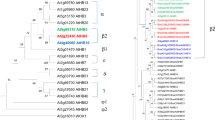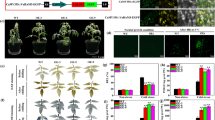Abstract
AtFes1A is a co-chaperone of heat shock protein 70 (Hsp70), which is a key component of plant molecular chaperone systems. Plants without AtFes1A generally present defective thermotolerance. However, the underlying mechanism of this molecule has remained elusive. In the present study, we used thermolabile firefly luciferase as a molecular reporter to evaluate the efficiency of the plant molecular chaperone system. Renaturation of firefly luciferase in atfes1a mutants lagged far behind that of wild-type (WT) plants. In contrast, in vitro AtFes1A did not affect renaturation of firefly luciferase, whereas Hsp70 did significantly. We propose that AtFes1A is indirectly involved in plant molecular chaperone systems.
Similar content being viewed by others
References
Abrams JL, Verghese J, Gibney PA, Morano KA (2014) Hierarchical functional specificity of cytosolic heat shock protein 70 (Hsp70) nucleotide exchange factors in yeast. J Biol Chem 289:13155–13167
Charng YY, Liu HC, Liu NY, Chi WT, Wang CN, Chang SH, Wang TT (2007) A heat-inducible transcription factor, HsfA2, is required for extension of acquired thermotolerance in Arabidopsis. Plant Physiol 143:251–262
Forreiter C, Kirschner M, Nover L (1997) Stable transformation of an Arabidopsis cell suspension culture with firefly luciferase providing a cellular system for analysis of chaperone activity in vivo. Plant Cell 9:2171–2181
Gowda NKC, Kandasamy G, Froehlich MS, Dohmen RJ, Andréasson C (2013) Hsp70 nucleotide exchange factor Fes1 is essential for ubiquitin-dependent degradation of misfolded cytosolic proteins. Proc Natl Acad Sci (USA) 110:5975–5980
Hong SW, Lee U, Vierling E (2003) Arabidopsis hot mutants define multiple functions required for acclimation to high temperatures. Plant Physiol 132:757–767
Hong SW, Vierling E (2000) Mutants of Arabidopsis thaliana defective in the acquisition of tolerance to high temperature stress. Proc Natl Acad Sci (USA) 97:4392–4397
Kityk R, Kopp J, Sinning I, Mayer MP (2012) Structure and dynamics of the ATP-bound open conformation of Hsp70 chaperones. Mol Cell 48:863–874
Kolb VA, Makeyev EV, Spirin AS (1994) Folding of firefly luciferase during translation in a cell-free system. EMBO J 13:3631–3637
Larkindale J, Hall JD, Knight MR, Vierling E (2005) Heat stress phenotypes of Arabidopsis mutants implicate multiple signaling pathways in the acquisition of thermotolerance. Plant Physiol 138:882–897
Lee GJ, Vierling E (2000) A small heat shock protein cooperates with heat shock protein 70 systems to reactivate a heat-denatured protein. Plant Physiol 122:189–198
Lee JH, Schöffl F (1996) An Hsp70 antisense gene affects the expression of HSP70/HSC70, the regulation of HSF and the acquisition of thermotolerance in transgenic Arabidopsis thaliana. Mol Gen Genet 252:11–19
Mayer MP (2013) Hsp70 chaperone dynamics and molecular mechanism. Trends in Biochem Sci 38:507–514
Mayer MP, Bukau B (2005) Hsp70 chaperones: Cellular functions and molecular mechanism. Cell Mol Life Sci 62:670–684
McLellan CA, Turbyville TJ, Wijeratne EMK, Kerschen A, Vierling E, Queitsch C, Whitesell L, Gunatilaka AAL (2007) A rhizosphere fungus enhances Arabidopsis thermotolerance through production of an HSP90 inhibitor. Plant Physiol 145:174–182
Ono K, Hibino T, Kohinata, T, Suzuki, S, Tanaka, Y, Nakamura T, Takabe T, Takabe T (2001) Overexpression of DnaK from a halotolerant cyanobacterium Aphanothece halophytica enhances the high-temperatue tolerance of tobacco during germination and early growth. Plant Sci 160:455–461
Shomura Y, Dragovic Z, Chang HC, Tzvetkov N, Young JC, Brodsky JL, Guerriero V, Hartl FU, Bracher A (2005) Regulation of Hsp70 function by HspBP1: Structural analysis reveals an alternate mechanism for Hsp70 nucleotide exchange. Mol Cell 17:367–379
Sung DY, Guy CL (2003) Physiological and molecular assessment of altered expression of Hsc70-1 in Arabidopsis. Evidence for pleiotropic consequences. Plant Physiol 132:979–987
Yi SY, Sun AQ, Sun Y, Yang JY, Zhao CM, Liu J (2006) Differential regulation of Lehsp23.8 in tomato plants: Analysis of a multiple stress-inducible promoter. Plant Sci 171:398–407
Zhang JX, Wang C, Yang CY, Wang JY, Chen L, Bao XM, Zhao YX, Zhang H, Liu J (2010) The role of Arabidopsis AtFes1A in cytosolic Hsp70 stability and abiotic stress tolerance. Plant J 62:539–548
Zhang X, Henriques R, Lin SS, Niu QW, Chua NH (2006) Agrobacterium-mediated transformation of Arabidopsis thaliana using the floral dip method. Nat Protoc 1:641–646
Author information
Authors and Affiliations
Corresponding author
Electronic supplementary material
Rights and permissions
About this article
Cite this article
Fu, C., Zhang, J., Liu, X. et al. AtFes1A is essential for highly efficient molecular chaperone function in Arabidopsis. J. Plant Biol. 58, 366–373 (2015). https://doi.org/10.1007/s12374-015-0181-y
Received:
Accepted:
Published:
Issue Date:
DOI: https://doi.org/10.1007/s12374-015-0181-y




